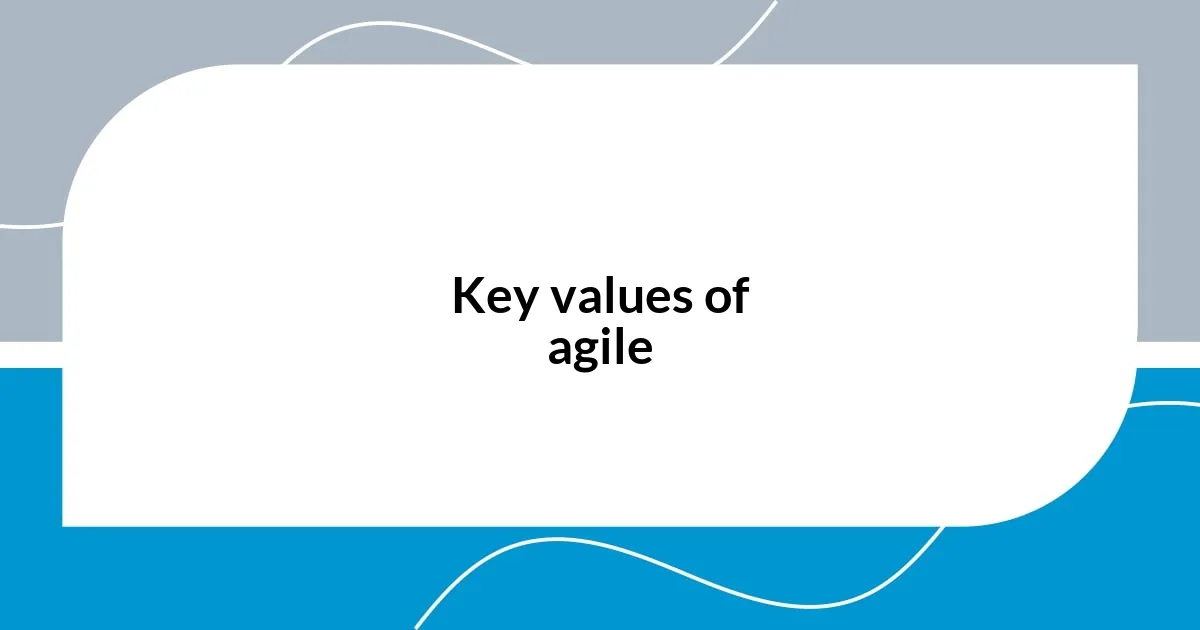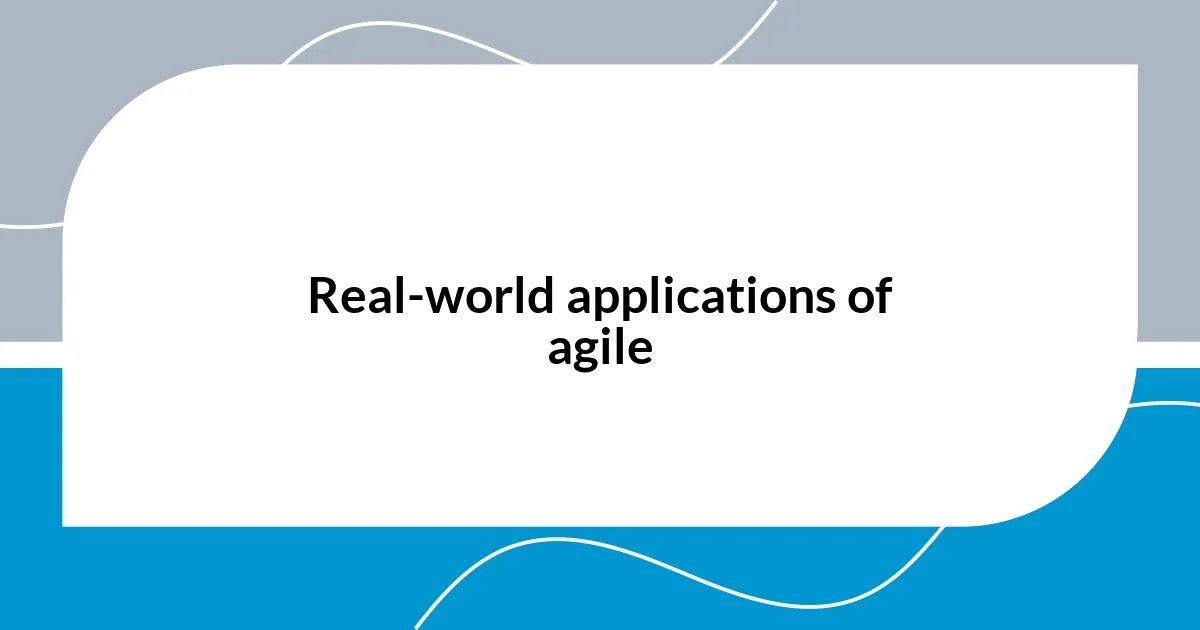Key takeaways:
- Agile methodologies emphasize flexibility, collaboration, and iterative processes, fostering an environment where teams can quickly adapt to changes and improvements.
- Key values include prioritizing individuals and interactions over processes, and responding to change rather than strictly following plans, enhancing creativity and ownership among team members.
- Collaboration is essential for accountability and skill sharing, transforming teams into learning units that foster camaraderie and innovative solutions.
- Success in agile projects is measured not only by metrics like velocity but also by customer satisfaction, team morale, and the quality of collaboration, promoting a supportive and inclusive team culture.

Understanding agile methodologies
Agile methodologies focus on flexibility and collaboration, creating a dynamic environment that encourages teams to adapt quickly to changes. I remember my first experience working on an agile project; the energy in the team was palpable. It was thrilling to see how quickly we could pivot our strategies based on client feedback. Have you felt that rush of innovation when a team collectively tackles issues and refines solutions in real-time?
At the core of agile is the iterative process, which breaks down complex projects into manageable chunks called sprints. I recall a particular project where breaking our workload into two-week sprints allowed us to celebrate small victories consistently, keeping morale high. This structure not only maintained our focus but also fostered a culture of continuous learning, where each sprint taught us something new about our approach and our clients’ needs. Isn’t it fascinating how these short cycles promote continuous improvement?
Communication also plays a decisive role in agile methodologies. I found that maintaining open lines of communication helped to eliminate misunderstandings and foster trust among team members. Have you ever noticed how much easier it is to resolve problems when everyone is on the same page? Regular stand-up meetings transformed our check-ins into a powerful ritual, allowing us to share progress and hurdles openly. In my experience, these interactions often spark amazing ideas that wouldn’t surface in a more traditional setup.

Key values of agile
One of the fundamental values of agile methodologies is individuals and interactions over processes and tools. In my early days diving into agile, I vividly remember a brainstorming session where every voice was heard, and ideas flowed freely. That rich exchange of perspectives not only boosted team creativity but also cultivated a sense of ownership among team members. It’s incredible to witness how prioritizing people transforms the way we approach challenges.
Another key value that resonates with me is responding to change over following a plan. I once worked on a project where, mid-way, market needs shifted dramatically. Instead of feeling overwhelmed, the team rallied together, adjusting our roadmap without losing momentum. This agility not only kept us relevant but also reminded me of the importance of flexibility. The following values underpin this ethos:
- Customer collaboration over contract negotiation
- Working software over comprehensive documentation
- Continuous attention to technical excellence and good design
- Simplicity—the art of maximizing the amount of work not done.is essential
- Self-organizing teams

Importance of collaboration in agile
Collaboration in agile isn’t just beneficial; it’s essential. I’ve seen how working closely with cross-functional teams leads to innovative solutions that might not emerge in silos. For example, during one project, a developer and a designer brainstormed together and came up with a feature that significantly improved user experience. The synergy created in those moments is something I deeply value.
It’s interesting to note that collaboration nurtures accountability among team members. When everyone is actively involved, there’s a natural push to uphold commitments. I remember a time when our team faced a tight deadline; each member stepped up, motivated by a shared goal. That collective drive not only helped us deliver but also solidified the bonds we had built over time. The sense of camaraderie in those moments is something I’ll always cherish.
Finally, collaboration leads to shared knowledge and skill enhancement. In my experience, the more we worked together, the more we learned from one another. I fondly recall a peer mentoring me on a complex coding issue. This exchange not only resolved the problem but also enriched my skill set. Isn’t it heartening to think about how collaboration transforms teams into learning units?
| Aspects | Traditional Approaches | Agile Methodologies |
|---|---|---|
| Communication style | Formal and structured | Open and continuous |
| Team dynamics | Siloed and hierarchical | Collaborative and flat |
| Accountability | Individual-focused | Team-oriented |
| Problem-solving | Top-down directives | Collective brainstorming |

Flexibility and adaptability in agile
Flexibility and adaptability are at the heart of agile methodologies, shaping how teams respond to changing circumstances. I recall a specific project where our initial assumptions crumbled under new user feedback. Instead of rigidly sticking to our plan, we pivoted, redefining our goals based on real user needs. This experience highlighted how being adaptable not just salvages a project, but also strengthens the team’s resilience and ingenuity.
What’s fascinating is how this flexibility creates a culture of experimentation. I remember feeling a surge of excitement when we decided to test a bold new feature, even though it deviated from our original scope. The team embraced this spirit of trial and error, leading to unexpected breakthroughs. How often do we give ourselves the freedom to explore the uncharted? In agile, that freedom is not only encouraged but celebrated.
Ultimately, adaptability empowers us to embrace uncertainty with confidence. There was a time when we faced a sudden market shift that caused us to regroup and reevaluate our priorities. Instead of panicking, our team’s ability to adapt shone through—we brainstormed and strategized together, turning what could have been a setback into an opportunity for growth. Isn’t it amazing how flexibility can transform potential challenges into avenues for innovation?

Principles guiding agile practices
The principles guiding agile practices revolve around valuing individuals and interactions over processes and tools. I remember attending a sprint retrospective where we reflected on our communication styles. It was eye-opening to realize how much more effective we were when we prioritized dialogue over documentation. This emphasis on human connection not only fosters trust but enriches the collaborative spirit of the team.
Another significant principle is delivering working software frequently, which keeps the focus on creating tangible results. I often think of a project where we released weekly updates instead of waiting for a larger rollout. The feedback loops we established were invaluable, as they allowed us to quickly adapt based on user responses. Have you ever experienced that rush of excitement when seeing a new feature in action? That immediate impact is something that truly motivates me within an agile framework.
Moreover, fostering a culture of continuous improvement through reflection and adaptation is crucial. In one of my teams, we adopted a “fail fast” mentality that encouraged experimentation without the fear of mistakes. I distinctly remember a project where we tried out a new feature that ultimately didn’t resonate with users. Instead of viewing it as a setback, we analyzed what went wrong and turned that insight into a beloved feature in our next iteration. Doesn’t it feel liberating to think that each stumble is a stepping stone toward greater innovation?

Real-world applications of agile
The real-world applications of agile are as diverse as the projects it supports. One particularly memorable experience for me was in a software development team where we applied agile practices to revamp an outdated user interface. By using iterative design, we could test and incorporate user feedback almost immediately. I still remember the palpable excitement in the room as we saw the interface transform in real-time. How often do we get to witness our ideas come to life so swiftly?
In another instance, I was part of a marketing campaign team that embraced agile methodologies to respond to the dynamic landscape of social media trends. We structured our workflow around bi-weekly sprints, allowing us to swiftly adapt our messaging based on audience reactions. I remember how empowering it felt when our team pivoted instantly to capitalize on a viral trend, ultimately resulting in a remarkable boost in engagement. Isn’t it invigorating to know we can ride the wave of trends rather than be swept away by them?
Agile doesn’t just apply to tech-based projects; I’ve seen its benefits extend to educational initiatives. During a curriculum development project, my team adopted agile principles to foster collaboration among educators. We held regular check-ins to gather feedback on lesson plans, which fostered a continuous loop of improvement. I remember how gratifying it was when we collectively reshaped the curriculum based on teacher insights. It really made me appreciate how agile can enhance teamwork and creativity, regardless of the industry. How transformative would it be to have this mindset in every aspect of our work?

Measuring success in agile projects
Measuring success in agile projects can sometimes feel like trying to catch smoke with your bare hands. I’ve often leaned on metrics like velocity—essentially how much work gets completed in a given time frame—as a good starting point. But I learned early on that it’s so much more than just raw numbers. One project taught me that customer satisfaction and team morale are equally important indicators of success. When we prioritized gathering feedback from users, the positive energy in the team surged because we could directly see how our efforts impacted real people.
Another lesson I encountered was the value of the ‘Definition of Done’ (DoD). I remember a project that felt chaotic because we didn’t have a clear DoD; not everyone agreed on what signified completion. It was frustrating until we collectively refined our criteria. Suddenly, the clarity changed everything. We celebrated not just the delivery of features but how well they met user needs and our standards. Isn’t it incredible how a simple guideline can bring focus and cohesion to a team, ultimately amplifying our success?
Lastly, the quality of collaboration really weighs on my definition of success in agile. I once joined a project where transparency and open communication were non-negotiable. Our daily stand-ups were more than just status updates; they turned into brainstorming sessions where everyone’s voice mattered. This culture of inclusivity led to innovative solutions that we probably wouldn’t have arrived at otherwise. Reflecting on that experience made me realize that measuring success isn’t solely about delivering on time; it’s about nurturing an environment where each team member feels empowered to contribute, don’t you think?